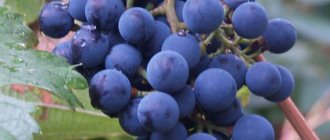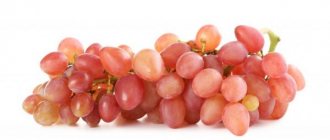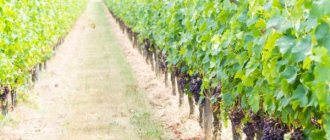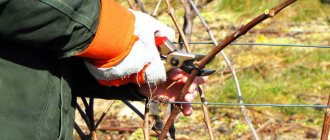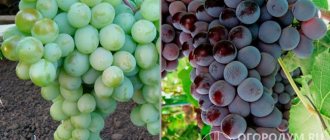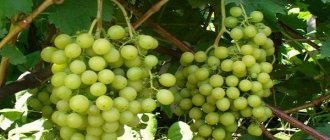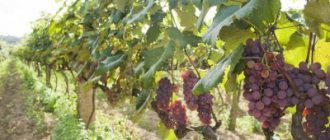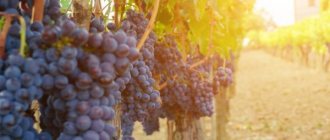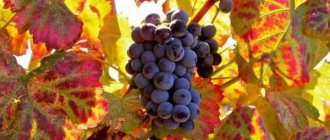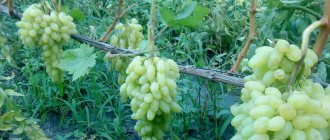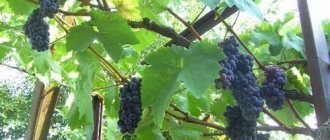The Rumba grape is a very beautiful, commercial variety of super early red grapes. He was bred by the experienced Russian folk breeder Vasily Ulyanovich Kapelyushny. Vasily Ulyanovich, being a practitioner and breeder not by profession, but by vocation, developed many famous table hybrid forms with a high degree of commercial qualities. Its hybrids are distinguished by very good resistance to sudden changes in weather and strong immunity against fungal infections.
“Rumba” is also a unique variety that combines qualities that allow it to compete with the best early grape varieties. It is the variety of choice for many professional winegrowers. She participated in numerous exhibitions where the form was recognized as promising. Features and description of the Rumba grape variety with photos are given in this article.
Botanical description
The Rumba grape is a very early, table, consistently high-yielding and resistant variety. Its yield is high: 60 kilograms of grapes are harvested from a bush that has entered full fruiting. Withstands winter frosts of -22-24 0C without shelter. However, in harsh winter conditions, it is best to cover this variety in order to protect the fruiting buds from freezing.
The Rumba grape has a flower with male and female flowering types. There are no problems with pollination of this hybrid even in unfavorable years, and the grape bunch always develops practically without peas.
Pros and cons of the variety
Rumba grapes have a lot of advantages, among them it is worth highlighting:
- early ripeness and large fruit;
- high and stable productivity;
- excellent taste;
- versatility (although it is a table variety, its sweet berries can be used to make wine);
- resistance to low temperatures, diseases and cracking of berries;
- good transportability (thick skin reliably protects the grapes from damage).
The variety has practically no disadvantages, except that its growth force makes the bush very thick. Therefore, grapes need regular pruning, as well as regulation of fruiting. If you leave the entire ovary, the berries will be crushed.
Characteristics of the vine of the hybrid form “Rumba”:
The sleeves of this variety have a colossal growth force and stretch to a length of up to six meters or more during the season. The leaf is medium in size, five-pointed, dark-colored, carved along the edge, with pronounced tiles.
The vines have time to ripen very well during the season. The percentage of vine ripening is more than 80%.
Bushes of this variety are usually planted at a distance of 2.5 meters between rows and 3-4 meters are left between plants. A feature of the form is its tendency to thicken with shoots. For this reason, short and medium pruning is carried out on Rumba vines. The optimal number of fruit buds is 50-60 per plant.
Also in the agricultural technology of the variety, rationing of shoots and bunches plays an important role. During spring work, approximately 16-18 fruit shoots are left for each adult bush. When forming on a two-strip trellis, this amount doubles. Plants overloaded with clusters cope with the harvest, but outwardly such clusters are smaller and the berries in them are smaller. The ripening time for grapes on such bushes is longer.
Features of cultivation
“Rumba” is certainly an unpretentious variety. However, you can count on a plentiful and high-quality harvest only if the bushes are planted correctly, provided with proper watering and fertilizing, and timely pruning.
Landing
Planting of seedlings can be done in spring, summer and autumn. The main condition in the case of autumn planting is that the minimum night air temperature during the month should not be below 0 °C; in the spring, the plant can be planted only after the soil has warmed up to +15 °C in depth. In summer, it is permissible to plant grapes purchased in a container.
You need to choose an open, well-lit place, protected from drafts and gusty north winds.
The variety prefers fertile soil with good aeration and moisture permeability, but is generally unpretentious and can grow on rocky or sandy slopes.
Watering and fertilizing
The first watering is carried out 15-20 days after planting the seedlings, then, subject to favorable weather conditions and sufficient rainfall, the plants are watered:
- 14 days after pruning;
- during the growing season;
- before flowering begins;
- during the formation of berries.
The water should be warm and settled. Approximate consumption is 2-3 buckets for each bush. After watering, the ground around the bushes is mulched with dry leaves, straw or sawdust to retain moisture.
Reference! The need for watering is indicated by a completely dry top layer of soil.
The harvest will not be abundant if the bushes do not have enough fertilizer. So, for each bush it is necessary to apply 2 liters of ash annually, and also use foliar feeding:
- before flowering - complex mineral fertilizers;
- during flowering and fruiting - phosphorus-potassium fertilizers.
Potassium salt must be added before covering the bushes for the winter.
Trimming
Proper pruning is a factor affecting the taste and quality of berries. The procedure is carried out 3 times a year:
- in spring - before sap flow begins, it is necessary to get rid of frozen vines;
- in summer - removal of excess shoots, bunches and shoots;
- in the fall - before winter shelter, the bushes are pruned so that 6-8 eyes remain on the vine.
After spring pruning, 16-18 fruit shoots should remain on an adult bush, and 32-36 if we are talking about formation on a two-lane trellis.
Reference! The variety is recommended for short and medium pruning - each bush should have 45-50 fruit buds.
Diseases and pests
The variety has good immunity to gray and berry rot and powdery and downy mildew. However, before the beginning of the flowering period and during it, the bushes still need to be treated with fungicidal preparations that contain phosphorus. The use of chemicals during fruit formation is prohibited.
Improper care of plants can lead to itching. Otherwise, this variety is practically not affected by insect pests, but the berries attract wasps and hornets.
Cancer on grapes
Frost resistance
The variety can tolerate frosts down to -25 °C. However, young seedlings and bushes grown in northern regions with harsh winters should still be covered.
Harvest storage
If stored at room temperature, the crop retains its quality for a maximum of 5-7 days. If you store grape bunches in a dark room with good ventilation and an air temperature of +8...+10 °C, the berries do not lose their taste and commercial quality for up to 6 months.
Important! Bunches that are planned to be stored should not be washed.
Characteristics of the bunches:
The bunch of the Rumba grapes is beautiful, conical in shape, there are several branches fused to the main ridge, of moderate density, reaching 25-40 centimeters in length. Depending on the bush's supply of wood, it weighs 0.8-1.2 kilograms or more. The berries are not prone to cracking. They also have difficulty breaking away from the central ridge, even when hanging on the bush for a long time.
During prolonged rains, sometimes several berries in the cluster may burst, but this grape variety does not suffer greatly from excess moisture. You just need to remove the spoiled berries and the bunch will not change its presentation. Wasps do not fly to Rumba and do not destroy its crop. A rare case occurs when a wasp flies up to a berry that has already burst for some reason, but the wasps themselves cannot gnaw through the skin of this variety.
Mermaid grapes variety description photo reviews
Parent pair: Mirny x Hybrid V-6
How to grow
The basic rules for forming Kishmish Radiant grape bushes are as follows:
Einseth sidlis in the vineyard
Ural
Ripens very early, table variety. The clusters are massive, 630 g. The berries are very large, dark red-violet, fleshy, with a hint of nutmeg in the taste. Sugars – 19%, acids – 4.6%. The tasters' verdict is 8.9 points.
Characteristics of the Rusbol grape variety
Rusbol is an early ripening muscat variety of table grapes. The growing season is 115–125 days. The flowers are bisexual. Rusbol serves as a pollinator for all grape varieties that have the same flowering periods.
The amber-yellow oval fruits have a sweet, musky taste. The tasting score for fresh grapes is 7.6 points, and for dried sultanas - 7.8. The pulp is fleshy and dense. Berries of class IV seedlessness, that is, with fairly large rudiments of seeds 40–60 mg. Rusbol's vestigial seeds give a pleasant, unique flavor to raisins. The weight of one berry is 3–4 g. The stems of the berry are medium. Sugar content – 19–21%, acidity – 5–8 g/l. The skin is thin, barely noticeable when biting into the grape. The weight of the bunch is 400–600 g, sometimes up to 1.5 kg. Typically, the first inflorescence on the vine eventually gains weight up to 1 kg, the second - about 600 g, the third - about 400 g. The bunch is moderately dense or moderately loose, depending on the shading. On average there are 1.5–1.9 bunches per shoot. The transportability and commercial qualities of the crop are average, the berries are not stored for so long, but since the variety is rarely grown for sale due to its rudimentary seeds, the bush, when planted with its own roots, begins to bear fruit in the second year. The fruits are intended for fresh consumption or for drying.
With this lighting, the main disadvantage of Rusbol is clearly visible - rudimentary seeds
Muscat grape varieties are called grape varieties that have a distinct musky flavor. Today, scientists believe that this is the oldest group of varieties, and the very first domesticated grape was Muscat.
The bush is medium-sized, easily propagated by cuttings and has excellent compatibility with most rootstocks. Frost resistance –25С°. Rusbol has established itself as a non-covering variety.
Muscat grape varieties are called grape varieties that have a distinct musky flavor. Today, scientists believe that this is the oldest group of varieties, and the very first domesticated grape was Muscat.
Characteristics of berries:
The berries in the cluster are oval, elongated, nipple-shaped or ovoid in shape with an elongated end, reaching a mass of 6-10 grams. The color of the berries is very beautiful, amber-pink to red. Length up to 20-30 mm, berry width reaches 15-18 millimeters. The bunch is loose. Sugar accumulation is 18-20%, with an acid content of 5-7 g/l. Taste assessment by the tasting commission -8.2 points.
Comparison with analogues
“Rumba” is a promising grape variety, the combination of positive characteristics of which allows it to compete with other early varieties that have already proven themselves.
| Sign | Variety | ||||
| Rumba | Agate Donskoy | Sofia | Pink haze | Rusven | |
| Ripening period | 95-102 days | 115-120 days | 100-115 days | 115-120 days | 110-115 days |
| Frost resistance | Up to -25 °C | Up to -26 °C | Up to -21 °C | Up to -23 °C | -25…-27 °C |
| Yield per bush | 60 kg | Up to 50 kg | 50-70 kg | About 6 kg | 13-16 t/ha |
| Bunches | From 800 g to 1.2 kg | 400-600 g | From 800 g to 1.2 kg | 700-800 g | 350-500 g |
| Taste | With cherry flavor and light nutmeg aroma | Simple, without aftertaste or aftertaste | With a nutmeg aftertaste | Harmonious | Pronounced nutmeg aroma |
| Color | Amber-pink to violet-red with a golden tint | Dark blue or violet red | Light pink | White-pink | Green-pink |
| Disease resistance | High | High | Average | High | Average |
| Shelf life | Up to 6 months | 2-3 weeks | 3-5 weeks | A few months | A few months |
| Sugar content | 20-23% | 13-15% | 20% | 16,8-18,5% | About 20% |
| Acidity | 5-7 g/l | 6-7 g/l | No information | 7 g/l | 7-9 g/l |
Product characteristics:
Since “Rumba” is a hybrid table form, it is consumed mainly in its natural form. If there is a surplus, the berries are processed into juices and compotes, or jams and other preparations are made from them.
The growing season for the hybrid form “Rumba” is 110-115 days. At the beginning of the last month of summer, the ripe pink-amber bunches are collected for sale. The product characteristics are exceptional and superior to its closest competitors. The bunches can hang on the bushes for a long time without losing their commercial qualities. Even when hanging on bushes, the aroma of ripe cherries in the aftertaste of the grapes is better revealed. Also, the coloring from hanging for a long time in the sun’s rays only becomes more intense.
Reviews
Numerous reviews of Rumba grapes testify to the unpretentiousness of the variety, its high yield and unusually sweet berries.
Grigorieva Polina Sergeevna, 57 years old, Kursk region
I am very pleased that I planted the Rumba variety. The seedlings yielded a harvest in the third year, the berries are sweet, the sourness is not felt at all, there are no burns - an excellent variety.
Rybakov Ivan, 68 years old, Voronezh
Rumba grapes grow on any soil and do not require frequent fertilizing. The bunches are large and beautiful, have an excellent presentation, retain their fresh appearance and excellent taste for a long time.
Petrova Valentina, 62 years old, Volgograd
The Rumba variety is a very successful purchase. It produces an excellent harvest that is stored for a long time. Its large clusters with a golden-pink tint become a wonderful decoration for the New Year's table every year.
Medunov I.P., 72 years old, Moscow region
I have been growing this variety for several years now and would not trade it for any other. The Rumba variety is very easy to care for, and its sweet taste allows you to get excellent wine from the grapes.
A general description of the Rumba grape variety is presented in the table:
| Variety | name "Rumba" |
| Frost resistance | -23-24′ C needs to be covered for the winter |
| Disease resistance | high, 5-7 points |
| Pea planting | No |
| Sugar content | high 18-20% |
| Taste/aroma | regular, with notes of cherry |
| Raw materials for wine | Maybe |
| Consumed raw | yes, table variety |
| Transportable properties | tall, can be transported over long distances |
| Craving for the earth | It loves fertile sandy soils, but is unpretentious, and grows on both sandy and rocky slopes. |
| Productivity | High, 50-60 kg per bush |
| Color | Amber pink |
| Berry size | 20-30 mm, berry width reaches 15-18 millimeters |
| Shape/Weight of berries | It has a nipple- or olive-shaped shape, the weight of the berries is 6-12 grams |
Planting and care
Due to its high frost resistance, seedlings of this hybrid can be planted in both spring and autumn . However, it is important to remember that freezing temperatures at night can kill them. You can plant it in any soil, the main thing with Rumba is care.
It is VERY IMPORTANT that the seedlings have a well-developed root system, so the distance between individual bushes should be at least 3 meters.
Before planting, it is recommended to trim the roots of the seedlings a little and soak them in a solution of growth enhancers. A young shoot should have no more than four eyes, and the growth length should reach 15 - 20 cm.
The plant is buried in a hole with a diameter of slightly less than one meter, the bottom of which is pre-filled with organic fertilizers. It is not recommended to fill the hole completely; it is better to leave about 5 cm of free space. Then you need to water the plant with two buckets of water and cover those same 5 cm holes with mulch.
During the growth process, Rumba has typical watering mechanics , taking place from April to October. Don't forget about mulching, as it retains moisture in the soil much longer. You can use both special factory materials and standard organic products (cones, compost, fallen leaves, etc.).
As mentioned above, Rumba tolerates frost well, so in the southern regions the bushes do not need to be covered for the winter.
If you live in a very cold winter, then the plant should be covered. The vines need to be tied and laid on the ground, before placing something on it (for example, plywood) to protect the shoots from rotting.
After this, it is recommended to stretch plastic film over the laid grapes.
To prevent too much stress on the grapes and subsequent reduction of berries, the number of shoots must be regulated.
A small bush should be left with about 20 brushes, and an adult - 45. All other shoots should be trimmed.
Transportation and storage
The grapes are distinguished by excellent marketability of the bunches. It is always popular in the market due to its taste, attractive color and elongated shape of the berries. Rumba grapes should be stored in a cool place with good air conditioning. The temperature for long-term storage of bunches must be constant. It is maintained at 8-10 degrees. In terms of storage time, storage can be long; sometimes the bunches wait for their buyer for 6 months. The advantage of this form is that storage does not affect its product and taste characteristics.
During transportation, it does not lose berries, which adhere perfectly to the combs. It can withstand long-distance transportation without any problems.
Rules for planting Rumba grapes
To plant this variety, you need to select seedlings that have well-developed roots and young shoots about 20 cm long. Each of them should have no more than 4 buds.
Several recommendations will help you plant Rumba grape seedlings correctly:
- one day before planting, the roots of the seedlings are slightly trimmed and placed in a nutrient solution;
- the root system of the seedling is carefully placed in the hole and covered with earth, compacting layer by layer;
- the hole is not completely filled, leaving a small depression of a few centimeters around it;
- 2-3 buckets of settled water are poured into the recess;
- loosen the soil around the bushes after watering to facilitate the availability of oxygen for the roots, and then mulch it;
- the vines are tied to vertical supports to guide them.
Harvesting and preparing for winter
Grapes are picked as they ripen - when the color is closer to pink. You can pick whole bunches; they are easily separated from the branches. The bunches are stored at home in a cool place for no more than 3-4 weeks. Without refrigeration, ripe grapes can last up to a week at room temperature. You need to wash the berries just before consumption; if the grapes are going to be stored for storage, they cannot be washed.
When the collection is over, excess shoots and dry branches are cut off. The cut areas are treated with peroxide to protect against bacteria. If the winter in the region is not cold, the temperature does not drop below 5-10 degrees, then the crop does not need to be covered. When growing Rumba in the central part or Siberia, the shoots are covered with plastic film for the winter, and the ground is mulched with sawdust.
Care
Already in the first growing season, young shoots need to be tied to a support.
The grape variety is considered one of the most unpretentious. No wonder people dubbed it “Sweet grapes for lazy people.”
Following simple recommendations for caring for grapevines always generously rewards winegrowers with a rich harvest.
Watering
For full development, a young grape bush requires at least 3-4 buckets of water weekly.
- Fleshy shoots require a lot of moisture throughout the entire growth period from early spring to late autumn. Primary watering is carried out during planting, subsequent watering is carried out after initial pruning. The plant especially needs moisture in the period before budding.
Watering Rumba grapes during flowering and berry setting is strictly prohibited It can cause the ovary to fall off and significantly reduce yield.
Watering is carried out in the soil around the vine with warm water, followed by mulching the root hole in such an amount that the moisture completely goes into the soil without stagnating on the surface.
Do not heavily moisten the soil during the ripening period , this can significantly delay the harvest and spoil the presentation of the fruit (the skin of the grapes cracks).
Trimming
Rumba's shoots grow very quickly, regardless of weather conditions, and are among the first to cross the two-meter mark.
The vines of this variety are prone to the rapid formation of numerous side shoots. If their numbers are not regulated in a timely manner, this will lead to thickening of the bush and loss of part of the harvest.
Up to 18–20 clusters are left on young vines, and no more than 40 on mature vines. The number of growth buds on other shoots should not be more than 7–8.
In cold regions, the clusters are torn off from the shoots; in warm climates, they can be left and a second harvest can be harvested by October.
Feeding
The first 2-3 years before fruiting begins, the bushes do not need fertilizing.
Next, fertilizers are applied to the root hole as the soil becomes depleted. In the spring, feed the plant with a solution of ammonium nitrate (2.5 teaspoons), superphosphate (4 teaspoons) and potassium salt (1 teaspoon), 1 bucket of solution per bush . Fertilizing with slurry, diluted chicken droppings, wood ash, compost, and specialized fertilizers for vineyards is effective.
It is best to alternate different types of fertilizing , this will enrich the soil with all the necessary nutrients for the development of the vineyard.
Preventative treatment
This hybrid grape variety has good resistance to fungal diseases and damage from various types of pests.
Well-groomed vine.
The most effective measures to prevent the disease will be : timely weeding of weeds, thinning of shoots (pruning), cleaning the vine of old bark, under which pests can hide. The bushes are periodically sprayed with fungicides, alternating the preparations.
It is mandatory to treat plants with systemic fungicides or a solution of copper sulfate (0.1 kg of powder per bucket of water) before wintering.
Shelter for winter
The Rumba grape variety in southern regions with mild winters does not require additional artificial shelter.
In the south, Rumba grapes overwinter normally without shelter.
- In difficult weather conditions in the middle zone and more northern regions, especially with possible sharp fluctuations in plus and minus temperatures, it is better to cover the variety for the winter.
- After autumn pruning and processing, the grapevines, fixed with improvised means, are laid on the ground (with or without a substrate) and covered with film or sprinkled with a layer of soil.
Covering grapes under film.
The thickness of the covering layer, material or embankment depends on the climatic conditions of wintering.
Characteristics and description of the variety
The variety was bred in the last century in the Rostov region by Russian breeder V.U. Drop by crossing 2 varieties: Cherryl and Red Delight. During breeding, no favorable conditions were created, no special technology was used, thanks to which Rumba earned its unpretentiousness. The variety is considered amateur.
The grapes have large berries; one weighs from 8 to 10 grams.
The shape is beautiful, slightly elongated. The skin color is combined and combines several shades: pink turns into red with a coral tint. The berries have a matte coating - wax. The taste of the fruit is sweet with a weak nutmeg aroma, no sourness is felt. According to the taste rating, Rumba was given 4.6 points out of 5. The berries may turn out to be watery if the plant was flooded or it constantly rained in the region. Attention! When the fruits are overripe, they become cloying.
Rumba is most often bred for fresh consumption. The berries are quickly eaten due to their sweet taste. The fruits are suitable for making homemade wines and spirits and ferment well. The grape harvest is enough for both harvesting and fresh consumption. Fruit ripening begins in August. One bunch produces up to 1 kg of berries; the figure can reach 1.5 kg. Some gardeners grow Rumba for sale. The berries are well transported over long distances, do not crush, and retain their presentation.
Reproduction of the variety
To propagate Rumba grapes, the cutting method should be used. For this purpose, branches with 4 buds are cut from adult bushes. All leaf plates are cut off from the branches. The top is slightly shortened. The cuttings are kept in settled rainwater for 20 hours. After this, you can wrap them in plastic and place them in the basement until planting.
Grape cuttings
Before planting cuttings in the ground, it is recommended to treat them with a growth stimulator. Cuttings are planted in prepared containers filled with fertile soil and peat. The container is covered with glass and transferred to a warm room. The soil is systematically moistened with a spray bottle.
Diseases and pests
Rumba has good resistance to fungal diseases - oidium, mildew, and the berries are resistant to sunburn and various types of rot.
However, despite this, grapes should undergo annual preventive maintenance: fertilize the soil with potassium and phosphorus, treat the bush with fungicides, prevent weeds from overgrowing, and thin out the bushes for more fresh air.
To protect against pests, the trunks and sleeves of grapes should be constantly removed from the old bark, as well as comprehensive spraying with protective chemicals (Fury, Zolon, Bi-58).
IMPORTANT! When using chemical treatment, you should remember about personal protective equipment and the timing of entering the area after spraying.
From all this we can conclude that due to its protective qualities, resistance to frost and excellent presentation, Rumba is a good choice for any gardener. And the soft, sweet taste will not leave any buyer indifferent.
External characteristics
"Rumba" looks very attractive and powerful, as the bushes grow very strongly. The trunk of the plant is thick and durable. The bushes form quite quickly and develop well in a short period of time. The leaves have a very interesting shape, they are five-fingered and somewhat reminiscent of an irregular circle with jagged ends. The color of the leaves is light green, sometimes a slight yellowish-green tint may appear towards the tips. Due to the rapid growth of the vine, which can reach up to 6 m in length per year, the grapes should be planted near fairly high fences or arbors so that the vine can cling to something and grow upward.
Bunches of grapes are loose in the shape of a cone or cylinder. The clusters look very elegant and are quite large in size. The average weight of a bunch is from 800 to 1100 g, but very often the bunches can reach 1500 g in weight. If you did not have time to remove the bunches after the berries ripened, then this is not a problem. Ripe grape bunches can remain on the plant for a long time without losing their taste and presentation.
Rumba is a pink table grape that is so loved by gardeners, wine growers, winemakers and just ordinary consumers for the taste and appearance of its berries. The fruits of this variety immediately attract your attention, as they look very harmonious against the background of the green, long vine.
Pest control and disease prevention
The Rumba grape variety is characterized by increased resistance to various diseases and pest invasions. However, improper care can cause itching on the plant. Small insects hide in the bark. Their presence can be indicated by cobwebs on the inside of the leaf plates. If timely treatment is not carried out, the foliage will begin to become covered with tubercles and fall off. If itching is detected, you should immediately remove the affected foliage and spray the bushes with disinfectants.
What does itching look like?
To prevent bush disease and pest invasion, you should promptly weed the soil to remove weeds and avoid thickening the shoots.
Rumba grapes are a high-yielding variety. The amazing taste characteristics and unpretentiousness of the plant are undoubted advantages. To grow healthy bushes, you should strictly follow the recommendations of experts regarding crop care.
